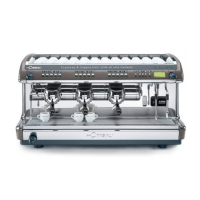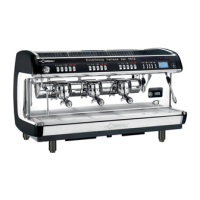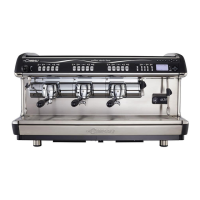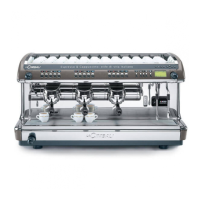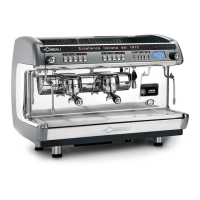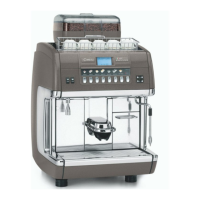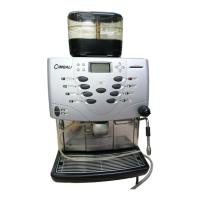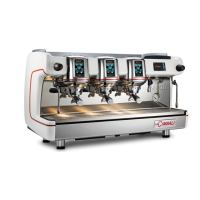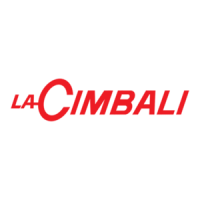Do you have a question about the La Cimbali M39 Classic TE and is the answer not in the manual?
Identifies main ON/OFF switch and boiler heat resistance controls.
Details buttons for continuous dispensing, STOP, hot water, and steam adjustment.
Describes indicator lights for cup warmer, machine status, auto-level, and pressure gauges.
Lists outlets, pipes, filter holder, tray, cups warmer, and advertising display.
Explains generic, electrical, trapping, hot surface, and environmental protection symbols.
Differentiates manual sections intended for operators versus qualified technicians.
Details the machine's design for espresso and hot beverages, and professional use.
Covers supervision for minors, unattended operation, and outdoor use.
Addresses temperature impact, atmospheric agents, water jets, and power cord safety.
Instructions for handling packaged machine, avoiding damage and environmental agents.
Procedures for checking the appliance upon arrival and eco-friendly disposal of packaging.
Ensures nameplate data matches electrical and water systems before connection.
Specifies suitable room temperature, surface, and proximity to utilities.
Mandates circuit breaker installation and verifies efficient earthing for electrical safety.
Advises against adaptors and checks voltage/connection types against nameplate.
Specifies water suitability, pH/chloride compliance, and hardness treatment needs.
Details water connection procedures, pressure reducers, and draining tube setup.
Checks for leaks and verifies normal operation of boiler, pressures, gauges, and valves.
Instructs to wash internal components before the first use for hygiene.
Requires washing internal components before starting and after idle periods.
Covers dispensing water/steam and cleaning coffee circuits daily.
Warns of hot areas, improper use, and provides general safety advice.
Details steps for safely shutting down the machine when left unattended.
Guides on immediate steps for malfunctions and contacting the service centre.
Emphasizes using qualified technicians and original spare parts.
Advises on electrical waste disposal according to EU directives and environmental best practices.
Provides step-by-step instructions for turning the machine on and off daily.
Details how to use the cup warmer and cautions against covering it.
Covers preparing cups and checking dispenser temperatures before dispensing.
Instructions for emptying, filling, and tamping coffee in the filter holder.
Guides on starting, stopping, and completing the coffee dispensing process.
Details steam dispensing operation and cleaning of steam nozzles and pipes.
Provides instructions for heating milk using the steam wand.
Explains how to dispense hot water using the dedicated key.
Highlights food safety compliance and recommends specific cleaning products.
Step-by-step procedure for flushing coffee circuits at the end of the day.
Detailed instructions for daily cleaning of filter holders and filters.
Explains the process of soaking filters in detergent solution and rinsing.
Instructions for cleaning steam pipes, hot water pipes, grille, and drip basin.
Procedures for cleaning the draining tray and the machine's bodywork.
Addresses issues like no power, leaks from filter holder rim, and water loss.
Covers short dispensing times, dripping coffee, and no coffee dispense.
Visual guides for wire colours, three-phase, and single-phase connection types.
Diagrams showing water connection and notes on maximum pressure.
Instructions on removing the tray and electric box lid to access components.
Guides for removing the front panel and managing cables at the terminal block.
Refers to subsequent pages for connection-specific instructions.
Lists the required nominal cross-sectional areas for electrical cables.
Provides colour codes for three-phase and single-phase electrical connections.
Illustrates the wiring for a three-phase connection with a neutral wire.
Illustrates the wiring for a three-phase connection without a neutral wire.
Diagram for single-phase connection at full power.
Diagram for single-phase connection at reduced power.
Explains how to change phase wire connections for different supply voltages.
Lists cleaning product categories for cappuccinators, groups, and machines.
| Type | Espresso Machine |
|---|---|
| Boiler Type | Heat Exchanger |
| Number of Groups | 2 |
| Voltage | 220-240 V |
| Hot Water Outlets | 1 |
| Steam Wands | 2 |
| Material | Stainless Steel |
| Water Supply | Direct Connection / Water Tank |

